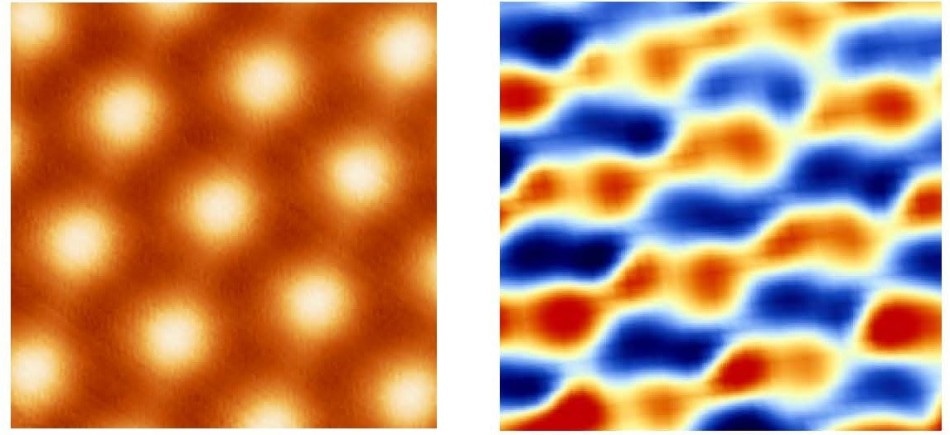Aug 5 2019
Overlaying two mesh screens causes beautiful patterns to develop when one screen is offset. These “moiré patterns” have fascinated artists, researchers, and mathematicians for a long time, and have been utilized in fashion, printing, and banknotes.
 Left: This image, taken with a scanning tunneling microscope, shows a moiré pattern in "magic angle" twisted bilayer graphene. Right: Scanning tunneling charge spectroscopy, a technique invented by Professor Eva Andrei’s group, reveals correlated electrons as shown by the alternating positive (blue) and negative (red) charge stripes that formed in the "magic angle" twisted bilayer graphene seen in the image at left. (Image credit: Yuhang Jiang/Rutgers University-New Brunswick)
Left: This image, taken with a scanning tunneling microscope, shows a moiré pattern in "magic angle" twisted bilayer graphene. Right: Scanning tunneling charge spectroscopy, a technique invented by Professor Eva Andrei’s group, reveals correlated electrons as shown by the alternating positive (blue) and negative (red) charge stripes that formed in the "magic angle" twisted bilayer graphene seen in the image at left. (Image credit: Yuhang Jiang/Rutgers University-New Brunswick)
Currently, a Rutgers-led team has found a way to solve one of the most longstanding mysteries in materials physics by finding out that in the presence of a moiré pattern in graphene, electrons arrange themselves into stripes, similar to soldiers in formation.
Their findings, published in the journal Nature, could assist researchers in the hunt for quantum materials, such as superconductors, that would function at room temperature. Such materials would greatly decrease energy consumption by making electronic devices and power transmission more effective.
“Our findings provide an essential clue to the mystery connecting a form of graphene, called twisted bilayer graphene, to superconductors that could work at room temperature,” said senior author Eva Y. Andrei, Board of Governors professor in the Department of Physics and Astronomy in the School of Arts and Sciences at Rutgers University–New Brunswick.
Graphene—an atomically thin layer of the graphite found in pencils—is a mesh composed of carbon atoms which resembles a honeycomb. It is an excellent conductor of electricity and a lot stronger than steel.
The Rutgers-led team examined twisted bilayer graphene, developed by superimposing two layers of graphene and misaligning them a little bit. This forms a “twist angle” that brings about a moiré pattern which alters quickly when the twist angle varies.
In 2010, Andrei’s team learned that besides being attractive, moiré patterns made using twisted bilayer graphene have a radical effect on the electronic properties of the material. This is due to the moiré pattern slowing down the electrons that conduct electricity in graphene and zoom past each other at phenomenal speeds.
At a twist angle of about 1.1°—the so-called magic angle—these electrons draw to a near standstill. The lethargic electrons start seeing each other and intermingle with their neighbors to move in lock-step. Consequently, the material attains remarkable properties such as magnetism or superconductivity.
Using a method invented by Andrei’s team to explore twisted bilayer graphene, the team found a state where the electrons arrange themselves into stripes that are sturdy and hard to break.
Our team found a close resemblance between this feature and similar observations in high-temperature superconductors, providing new evidence of the deep link underlying these systems and opening the way to unraveling their enduring mystery.
Eva Y. Andrei, Professor, Department of Physics and Astronomy, School of Arts and Sciences, Rutgers
Rutgers post-doc Yuhang Jiang is the lead author. Rutgers co-authors include post-doc Jinhai Mao, graduate student Xinyuan Lai and Professor Kristjan Haule. Researchers at the National Institute for Materials Science in Japan also contributed to the research.